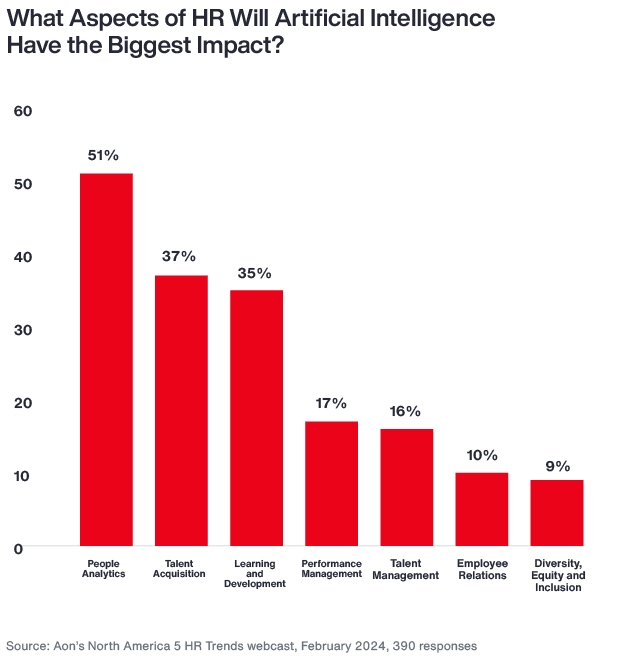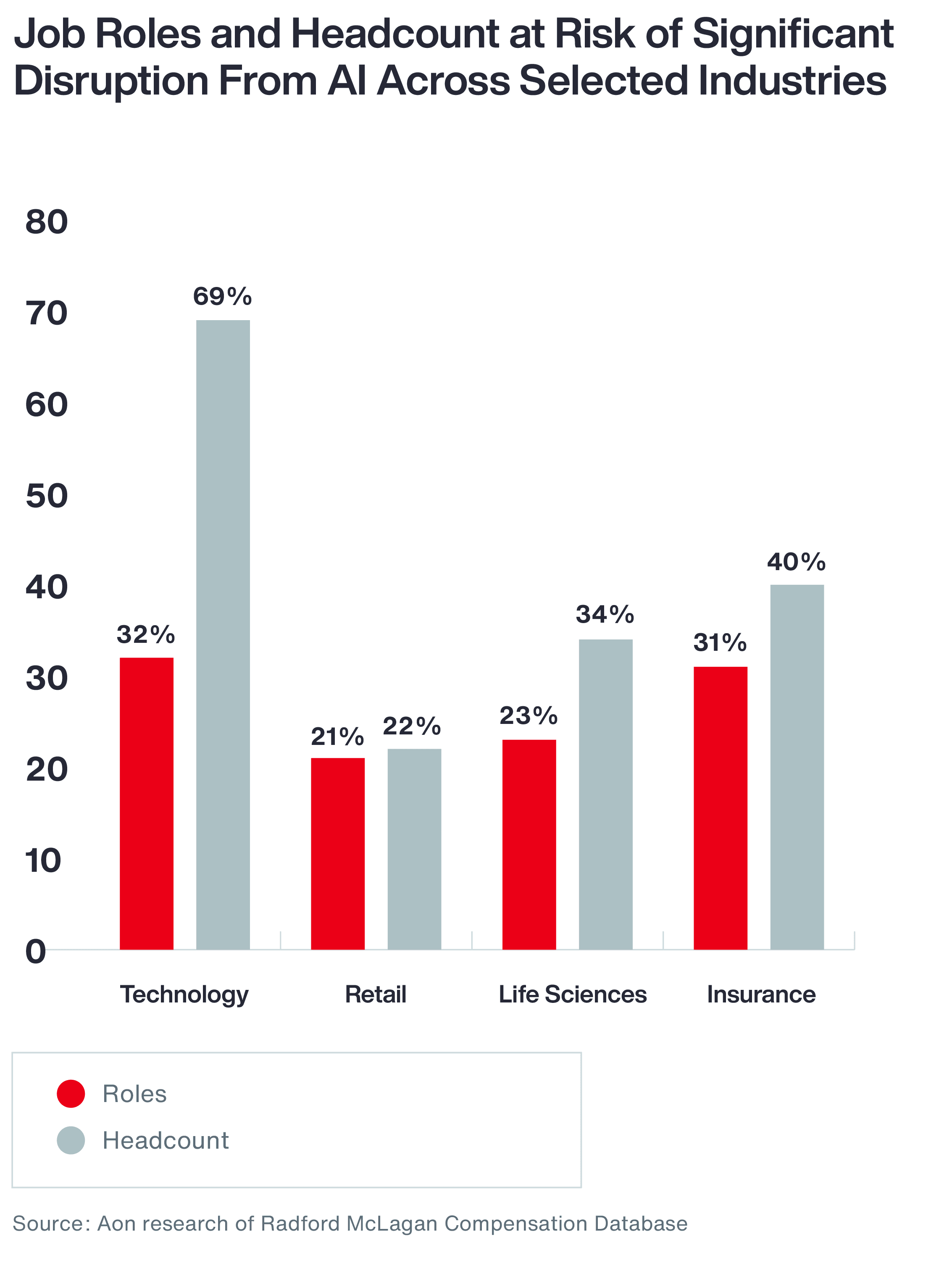More Like This
-
Capability Overview
Human Capital Analytics
-
Capability Overview
Talent and Rewards
-
Capability Overview
Health and Benefits

Artificial intelligence (AI) is disrupting all areas of business strategy. Aspects of AI, specifically predictive AI — which uses machine learning to identify patterns in past events and make predictions about future events — have been a part of HR functions for quite some time. But generative AI, involving the creation of content, will accelerate how technology interacts with the whole business and HR specifically. When it comes to managing the workforce in the era of AI, HR professionals need to consider the impacts and manage risks and opportunities across health and benefits, talent management and retirement.
There are two distinct ways that AI can have an impact on HR. First, AI itself can be used by HR professionals across the different functions of their role. For example, deploying predictive AI to identify high-cost health and benefits claimants or using generative AI to write job descriptions in the talent management space. Second, HR professionals can ready their organization’s workforce for the coming transformation that AI will create.
Capability Overview
Human Capital Analytics
Capability Overview
Talent and Rewards
Capability Overview
Health and Benefits
In a recent Aon survey, nearly 400 HR professionals said the areas of people analytics, talent recruitment, and learning and development would benefit the most from AI. People analytics is a discipline that can be leveraged in nearly all types of HR functions, such as identifying characteristics of the employee population, hiring strategy and pay and promotion trends.
"As with all new and rapidly changing technologies, it is natural for people to take a 'wait-and-see' approach," said Lambros Lambrou, Aon's CEO of Human Capital. "But when it comes to AI, human resources teams have a significant opportunity to lead the way. It's important not to miss the moment. By understanding how AI effects the workforce, HR can better prepare everyone for changes to come."

AI moved up 32 spots, from 49 to 17, in the risks currently faced by companies.
Source: Aon's Ninth Global Risk Management Survey
Different forms of AI have already provided cost savings and an enhanced employee experience in the healthcare sector.
By leveraging AI and machine learning, employers and providers can better understand the need and demand for care. The workforce will then be more likely to take advantage of these improved programs and benefits, resulting in positive health-related outcomes.
AI has been used to predict high-cost health plan claimants — a growing concern in the U.S. and globally. The top five percent of healthcare plan members on average in the U.S. account for more than 60 percent of the total employer healthcare plan. Even more troubling: the number of $1 million claimants rose by more than 45 percent from 2019 to 2022 — driven by specialized care, such as cancer treatment and new gene and cell therapies.
Aon worked with a multinational employer that had a large number of recurring high-cost polychronic members. The client wanted to improve engagement among plan members and clinical outcomes, with a focus on the members who were most likely to drive costs higher. Aon’s Health Risk Analyzer, which is powered by machine learning, was used to predict the future claims cost for each member of the plan. We found that half of the predicted high-risk cohort had not been identified by their current care management program, contributing to low engagement. Aon worked with the employer to use those predictions to optimize the employer’s health program by proactively engaging these high-risk members within care management.
As a result, 20 percent of the identified high-risk members were actively managed by the employer’s clinical programs, and ultimately likely to improve health and cost outcomes. This translates to an anticipated claim savings of over $2,000 per additional managed individual.
Drug discovery takes an average of 12-15 years and has a 90 percent failure rate. AI can help reduce that time to eight years on average, while increasing the chances of success.
Source: World Economic Forum
Aon uses machine learning in a variety of other tools to predict outcomes of interest to our health clients and evaluate the impact of vendor or insurance programs.
While concerns surrounding unknown AI and machine learning risks are valid, employers can’t afford to ignore the potential AI has for improving the health of their workforces. With AI-powered analytics, employers can synthesize and unlock insights to enable better decision making by:
These applications of AI are more of an evolution than a revolution. However, the same care must be taken as with any technology to safeguard employees’ private health information and other data.
AI has not yet been used as much in retirement planning as in other areas of HR. This is primarily because companies want to avoid having a tool that inadvertently creates a fiduciary responsibility where one hadn’t previously existed. There is concern that AI chatbots in particular could veer into giving advice that bots are not qualified to give, thus putting the organization in potential crosshairs with regulators.
That’s not to say that there aren’t possible uses for AI in areas of retirement planning. These include:
Employers can develop incentives for retirement that cater to individual needs and preferences with the help of AI. Employers today frequently rely on a one size fits all approach, but AI may be able to design programs that offer highly competitive benefits to employees that prioritize retirement savings, and less valuable retirement benefits to employees with other priorities.
Organizations may want a virtual assistant to help employees through the retirement process. These tools could process documents and recommend considerations for employees. Care must be taken, though, to ensure these tools refrain from exposing the fiduciary to additional risks.
In the United States, AI-driven technologies and algorithms are changing how annuities are structured, sold and managed. Virtual assistants will change the way participants select annuity providers and annuity contracts. Implementing these assistants directly into the retirement plan website could help reduce leakage and increase access to lifetime income.
AI can provide long-term financial planning insights by considering various life events and recommending tailored products. Managed accounts are one early implementation of this idea. We will likely see further innovation as AI is incorporated into these programs.
AI will unlock the power to easily segment and personalize communications, thereby encouraging member engagement. AI can also help with plan administration and using chatbots to answer questions, encouraging more self-service help.
An AI trustee could help improve performance, as could using data and analytics from AI to drive decision making. Using an AI tool to automate tasks could also free up professionals’ time to focus on strategy.
AI services will likely be developed to help plan administrators monitor the performance of asset managers and third-party vendors in real time. These tools will keep costs low and drive further efficiencies in the field. An AI assistant could also be useful to identify regulatory issues relevant to an employee question or even summarize information included in those regulations.
Other more routine uses include using chatbots to perform repetitive tasks, such as retrieving plan information to communicate to members and answering basic employee questions about plans.
However, HR professionals should keep in mind some potential pitfalls. For example, employers will need to verify identities carefully. Bad actors will likely deploy AI to gain personalized data that can later be used for fraud. These schemes already exist, but may be more widespread as AI permeates this space.
Another risk is data security. Employers will want to think carefully about which data should and should not be accessible by AI. Sending an employee’s personal identifiable information over the internet may expose the organization to a data breach.
Another tool being used in retirement is predictive analytics to prepare custom estimates of pensioner life expectancy for base mortality tables.
It is likely that no area of HR will be affected as profoundly by AI as talent management professionals. As AI is integrated into business strategy, preparing the workforce to use the new technology is critical. AI could require new skills, new jobs and new ways of working. An internal AI model can help predict employee retention or flight risks. Once identified, interventions can be recommended or even implemented by the AI model on behalf of a manager. For example, an employee may receive a reminder about an Employee Assistance Program if they signal to the AI model that they need help managing stress. Managing those requirements will fall to talent management professionals.
“The clients that I talk to know they have so much they need to comprehend that they're having trouble figuring out where to focus first,” says Marc Pajarillo, a partner in Aon’s Talent practice. “By and large, organizations need to start thinking about how all jobs will be substantively changed today versus tomorrow — and we’re helping them with this by analyzing jobs and seeing what can be automated compared to augmented and how they need to redesign jobs.”
Economists have been making predictions that new technologies would replace laborers since the Industrial Revolution.1 These predictions tend to overstate the degree to which workers would be replaced entirely, and undervalue the notion that workers would adapt, reskill and use the increased productivity afforded by automation to increase overall output. Thus, talent professionals should be looking toward preparing for the use of AI through the lens of reskilling and upskilling, as well as planning for the creation of new jobs to help manage AI successfully.
Using Aon’s extensive global workforce database, we analyzed the potential impact of AI on jobs across several industries. In the technology industry, we found 32 percent of job roles and 69 percent of headcount are at risk of significant disruption from AI. The level of disruption can vary greatly by industry. By contrast, our analysis of life sciences firms found 23 percent of job roles and 34 percent of headcount are at risk of significant disruption from AI.

While different industries will experience different levels of disruption, there is a constant across industries: HR professionals will need to lead the charge to both use the technology responsibly and prepare the workforce for its adoption. When we analyzed the HR function across industries, we found that 24 percent of roles and 58 percent of headcount will be disrupted.
A comprehensive strategy starts with workforce planning, including determining which jobs the organization needs and the effect on overall job architecture. While it’s interesting to know the projected overall disruption that AI will create in a given industry, it is more useful for HR and business leaders to understand the types of jobs that will be disrupted.
An HR trade group in the UK found that 91 percent of HR leaders think their HR professionals need further skills in using and applying technology like generative AI.
Source: Corporate Research Forum, January 2024
01
The first step is deciding which tasks can be automated or enabled by AI. Things like meeting scheduling or other repetitive tasks are best suited for automation. But the impact goes beyond automation of tasks. It may fundamentally change certain jobs in a way that cannot be reskilled or upskilled.
02
It’s important to determine which jobs will be impacted and how much, as well as set expectations around reskilling or upskilling versus replacing roles. Job design changes may impact salary ranges. It’s also important to plan for severance costs associated with workers whose roles become redundant.
03
Not to be ignored is communication. Managers should have clear talking points to share with employees about business potential and the need to upskill and reskill, while being forthright that roles may be eliminated. This will help ease some of the uncertainty driving the conversation around AI.
HR professionals have a strategic seat at the table when it comes to managing the transformation of the workforce that AI may bring. This will require professionals to understand which roles will change and how, and to harness the capabilities that are unlocked by using AI across the HR ecosystem — from health and benefits, talent management and retirement planning.
Inherent in the transformation will be governance of the process. Many of the fears around AI revolve around concerns about data security, over-reliance on unproven technology and a lack of control over the process of implementation. However, by keeping in mind the following considerations, many of those issues and fears can be mitigated:
Ensure the use of AI applications is aligned with the overall vision, mission and values of the company. Organizations that are committed to promoting inclusion and diversity, for example, should ensure AI recruiting tools are carefully vetted so they promote fair and unbiased hiring practices. Building trust in data, mitigating bias, maintaining data privacy and minimizing cybersecurity risk are all keys to responsibly integrating AI.
HR has a big role to play in establishing how people use AI. HR teams should monitor the performance and impact of any AI applications they use, while also supporting best practices within their organizations to identify, report and mitigate any potential errors, biases or harms. HR leaders and professionals should also partner with other functions to establish clear roles and responsibilities for the design, development, deployment and oversight of AI applications and related data.
As with other technology, AI does not replace HR leaders and professionals who intuitively understand AI is not a substitute for human intelligence or emotions, but rather a complement and an enabler. Therefore, HR leaders and professionals should invest in developing and enhancing employee skills and competencies to work with AI tools. This includes building data literacy, analytics and programming skills, as well as supporting soft skills like critical thinking, creativity, collaboration and emotional intelligence. Additionally, HR leaders and professionals should foster a culture of learning and innovation where employees are encouraged to experiment with and learn from approved AI applications.
While the hype about generative AI has been around for some time now, there are people who believe that the technology is not — and may never be — good enough for general use. AI is only as good as the dataset it is trained on, meaning bias and bad information may persist. And generative AI is prone to “hallucinations,” where the output of an AI prompt includes information that is wrong or fabricated.
Other concerns relate to intellectual property and how the AI models are trained. It’s true — many AI companies have been frustratingly vague at times. These issues underscore the need for organizations to adopt AI technology as they would any other new approach to working —carefully, thoughtfully and with best practices guiding the way.
Fifty-one percent of 376 HR professionals polled by Aon in February 2024 said they are not ready to use AI capabilities in their HR organization.
General Disclaimer
This document is not intended to address any specific situation or to provide legal, regulatory, financial, or other advice. While care has been taken in the production of this document, Aon does not warrant, represent or guarantee the accuracy, adequacy, completeness or fitness for any purpose of the document or any part of it and can accept no liability for any loss incurred in any way by any person who may rely on it. Any recipient shall be responsible for the use to which it puts this document. This document has been compiled using information available to us up to its date of publication and is subject to any qualifications made in the document.
Terms of Use
The contents herein may not be reproduced, reused, reprinted or redistributed without the expressed written consent of Aon, unless otherwise authorized by Aon. To use information contained herein, please write to our team.
Our Better Being podcast series, hosted by Aon Chief Wellbeing Officer Rachel Fellowes, explores wellbeing strategies and resilience. This season we cover human sustainability, kindness in the workplace, how to measure wellbeing, managing grief and more.
Stay in the loop on today's most pressing cyber security matters.
Our Cyber Resilience collection gives you access to Aon’s latest insights on the evolving landscape of cyber threats and risk mitigation measures. Reach out to our experts to discuss how to make the right decisions to strengthen your organization’s cyber resilience.
Our Employee Wellbeing collection gives you access to the latest insights from Aon's human capital team. You can also reach out to the team at any time for assistance with your employee wellbeing needs.
Explore Aon's latest environmental social and governance (ESG) insights.
Our Global Insurance Market Insights highlight insurance market trends across pricing, capacity, underwriting, limits, deductibles and coverages.
How do the top risks on business leaders’ minds differ by region and how can these risks be mitigated? Explore the regional results to learn more.
Our Human Capital Analytics collection gives you access to the latest insights from Aon's human capital team. Contact us to learn how Aon’s analytics capabilities helps organizations make better workforce decisions.
Explore our hand-picked insights for human resources professionals.
Our Workforce Collection provides access to the latest insights from Aon’s Human Capital team on topics ranging from health and benefits, retirement and talent practices. You can reach out to our team at any time to learn how we can help address emerging workforce challenges.
Our Mergers and Acquisitions (M&A) collection gives you access to the latest insights from Aon's thought leaders to help dealmakers make better decisions. Explore our latest insights and reach out to the team at any time for assistance with transaction challenges and opportunities.
How do businesses navigate their way through new forms of volatility and make decisions that protect and grow their organizations?
Our Parametric Insurance Collection provides ways your organization can benefit from this simple, straightforward and fast-paying risk transfer solution. Reach out to learn how we can help you make better decisions to manage your catastrophe exposures and near-term volatility.
Our Property Risk Management collection gives you access to the latest insights from Aon's thought leaders to help organizations make better decisions. Explore our latest insights to learn how your organization can benefit from property risk management.
Our Technology Collection provides access to the latest insights from Aon's thought leaders on navigating the evolving risks and opportunities of technology. Reach out to the team to learn how we can help you use technology to make better decisions for the future.
Trade, technology, weather and workforce stability are the central forces in today’s risk landscape.
Our Trade Collection gives you access to the latest insights from Aon's thought leaders on navigating the evolving risks and opportunities for international business. Reach out to our team to understand how to make better decisions around macro trends and why they matter to businesses.
With a changing climate, organizations in all sectors will need to protect their people and physical assets, reduce their carbon footprint, and invest in new solutions to thrive. Our Weather Collection provides you with critical insights to be prepared.
Our Workforce Resilience collection gives you access to the latest insights from Aon's Human Capital team. You can reach out to the team at any time for questions about how we can assess gaps and help build a more resilience workforce.

Article 11 mins
The London insurance market seeks a generation of game-changers who can navigate uncertainties and drive innovation to ensure the industry’s future success in a digitalised world.

Article 7 mins
From global supply chain risks to climate insecurity, organizations face challenges and complexities on a scale rarely seen before.

Article 9 mins
Risk Capital CEO Andy Marcell and Human Capital CEO Lambros Lambrou discuss how innovations in Risk Capital and Human Capital can help organizations boost resilience and navigate volatility.